When it comes to cutting tools, tungsten carbide is the go-to material for professionals who need strength, speed, and reliability.
But not all carbide tools are created equal. The grade of tungsten carbide you choose can greatly affect how your tool performs—and how long it lasts.
Whether you’re cutting aluminum, steel, or composites, using the right carbide grade is key to achieving the best results.
This guide helps you understand what carbide grades mean, why they are important, and how to choose the best grade for your job.
1. What Are Tungsten Carbide Grades?
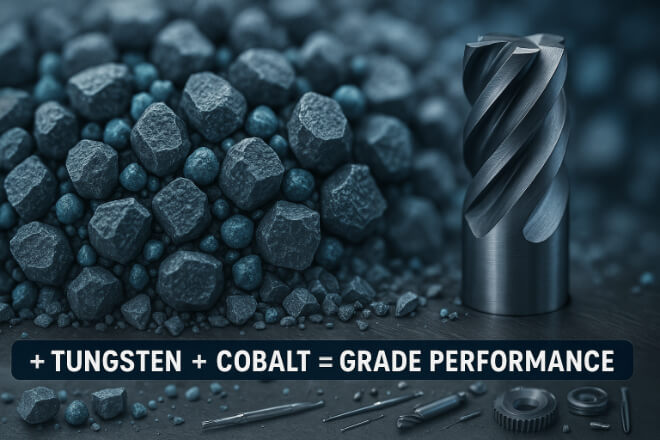
Tungsten carbide grades refer to different mixtures of tungsten carbide and other materials (like cobalt), which affect the tool’s 硬度, strength, toughness, and 耐摩耗性.
Think of it like choosing the right type of steel: some are great for strength, others for flexibility. With tungsten carbide, the mix determines how the tool behaves.
Basic Ingredients:
Tungsten carbide (WC): The hard particles
Cobalt (Co): The binder that holds the particles together
Different ratios and grain sizes create different grades—some better for tough jobs, others better for precise finishing.
2. Why Do Grades Matter?
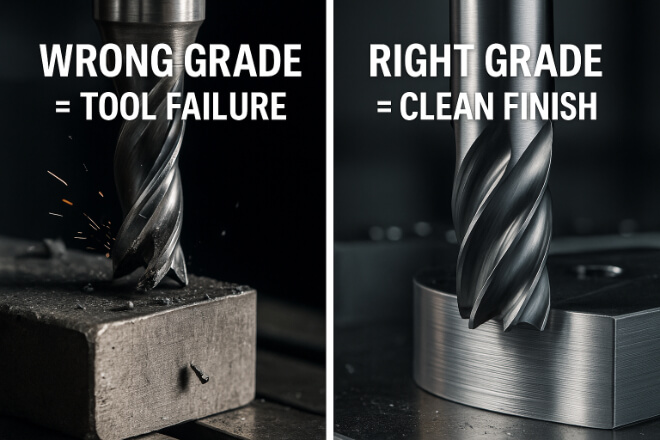
Using the wrong grade can result in:
Tool breakage
Premature wear
表面仕上げが悪い
Low productivity
Higher costs
On the flip side, the right grade means:
工具寿命の延長
Better surface quality
Faster machining speeds
Improved dimensional accuracy
That’s why selecting the correct tungsten carbide grade is critical in any machining operation.
3. How Grades Are Classified
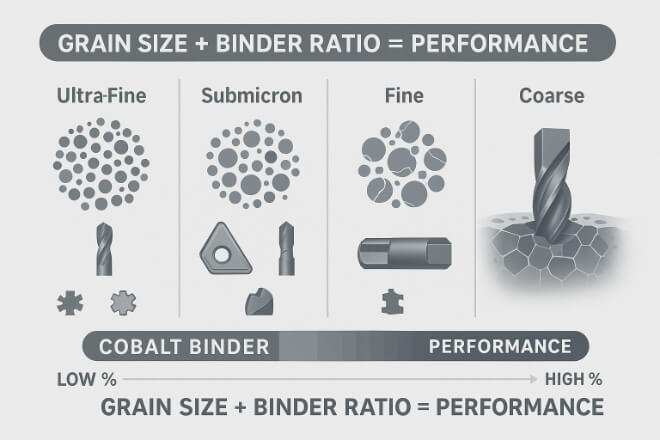
Tungsten carbide grades don’t follow a universal code, but most manufacturers use systems based on grain size, binder percentage, and application category. Here’s how they break down:
1). Grain Size (microstructure)
Ultra-fine (<0.5 µm): Great for sharp tools, high 耐摩耗性, and finishing
Fine (0.5–1.0 µm): Good for moderate wear and strength balance
Medium (1–2 µm): General-purpose, suitable for many jobs
Coarse (>2 µm): Better for toughness, less wear resistance
2). Binder Content (Cobalt %):
6–10% Co: Higher 硬度, lower toughness (best for hard materials)
10–20% Co: Greater toughness, better shock resistance
3). ISO Classification (for inserts):
P-grade: Steel
M-grade: Stainless steel
K-grade: Cast iron
N-grade: Non-ferrous (aluminum, copper)
S-grade: High-temp alloys (Inconel, titanium)
H-grade: Hardened materials
4. Common Tungsten Carbide Grades and Their Uses
Here’s a simplified reference chart showing typical carbide grades and what they’re good for:
| グレードタイプ | 粒度 | Cobalt % | 最適な用途 |
|---|---|---|---|
| Ultra-Fine (UF) | < 0.5 µm | 6–10% | Finishing, sharp edges, aluminum, plastics |
| Fine Grain (F) | 0.5–1 µm | 6–12% | General purpose, light steel, copper |
| Medium Grain (M) | 1–2 µm | 10–15% | Steel, cast iron, versatile applications |
| Coarse Grain (C) | > 2 µm | 15–20% | Heavy-duty, interrupted cuts, impact resistance |
5. Choosing the Right Grade for Your Application

Here’s how to pick the proper carbide grade depending on the material you’re machining:
1). Aluminum & Non-Ferrous Materials
Use ultra-fine grain carbide with polished flutes
Lower cobalt content for sharper edges
Ideal for high RPM and clean finishes
2). Steel (Mild, Alloyed)
Choose medium grain carbide with moderate binder
Look for coatings like TiAlN or AlCrN for heat resistance
3). Stainless Steel
Needs a balance of hardness and toughness
Go with fine grain, 10–15% cobalt
Avoid sharp corners—use rounded profiles
4). Cast Iron
Use harder grades, medium or fine grain
Sharp tools are less effective—opt for edge strength
5). Titanium & High-Temp Alloys
Require ultra-fine carbide with strong coatings
Avoid chip welding with DLC or TiAlN coatings
6). Hardened Steel
Needs low cobalt, high hardness carbide
Often paired with ceramic or PCD tips
6. Coatings Also Matter
Even the best carbide grade needs the right coating to perform well.
Here are some popular coating types used on carbide tools:
| コーティング | 最適な用途 | Key Benefits |
|---|---|---|
| 錫 | General use | 硬度が増す |
| TiAlN | Steel, high-temp alloys | Heat resistance, long tool life |
| アルティン | 硬化鋼 | Strong under high heat, dry cutting |
| ダウンロードコンテンツ | アルミニウム、プラスチック | Reduces sticking, smooth cutting |
Tip: Pairing the correct grade + coating is what separates good results from great ones.
7. Why Using the Right Grade Saves You Money
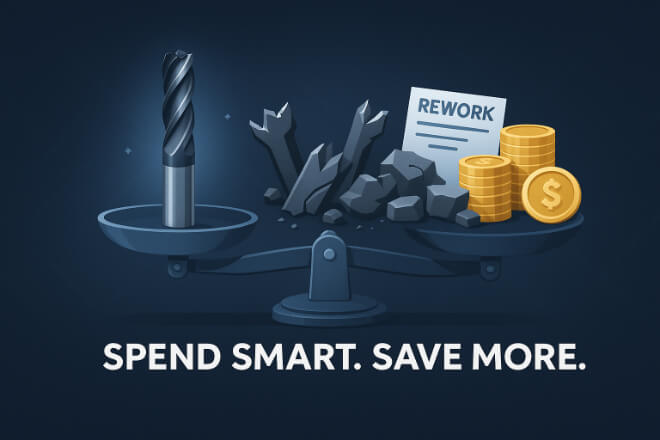
Many shops choose tools based only on cost. But using the wrong grade leads to:
Faster tool wear
頻繁な交換
Poor surface quality
More downtime and rework
The right carbide grade, on the other hand, helps you:
Run at higher speeds
Achieve better finishes
Reduce tool breakage
部品あたりのコストが低い
Increase your CNC efficiency
So while premium-grade tools might cost more upfront, they save you more in the long run.
8. Examples from Real Industries
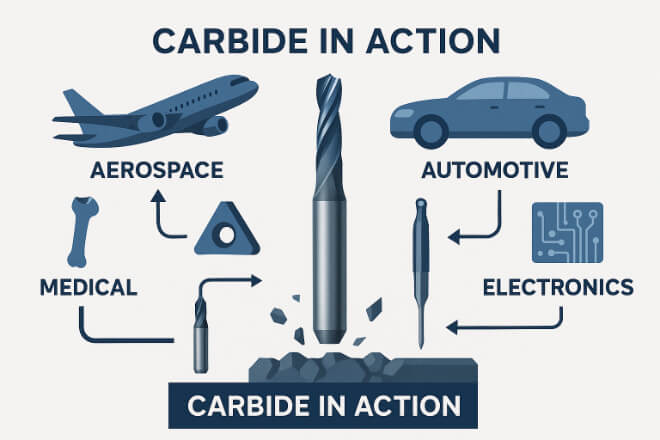
Let’s see how different industries benefit from using the right carbide grades:
1). 航空宇宙
Machining titanium and Inconel with ultra-fine grades
Long tool life even under extreme heat
2). 自動車
Coarse grain tools for roughing engine blocks
Fine grain for precision holes and surface finish
3). 医学
Micro tools using ultra-fine carbide for bone implants
High sharpness for burr-free cuts
4). Electronics
Finishing copper and plastics with DLC-coated fine grade tools
Burr control and high precision
9. Final Checklist: What to Ask Before You Choose

Before you buy your next cutting tool, ask:
What material am I cutting?
What operation am I performing (roughing, finishing, drilling)?
What level of heat and wear will the tool face?
Do I need shock resistance (for interrupted cuts)?
What surface finish do I expect?
最後に
Tungsten carbide tools are powerful—but only if you choose the right grade for your application.
By understanding grain size, binder content, and coatings, you can unlock longer tool life, smoother finishes, and faster machining.
Don’t just buy tools—match them to your needs.
企業の詳細を知りたい場合は、お気軽にお問い合わせください。 お問い合わせ.
